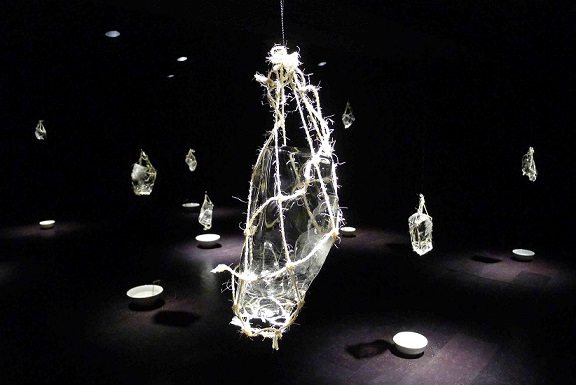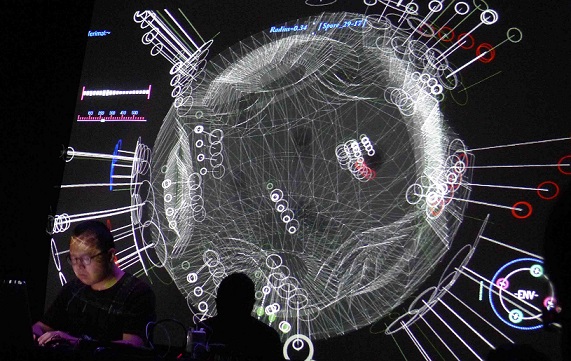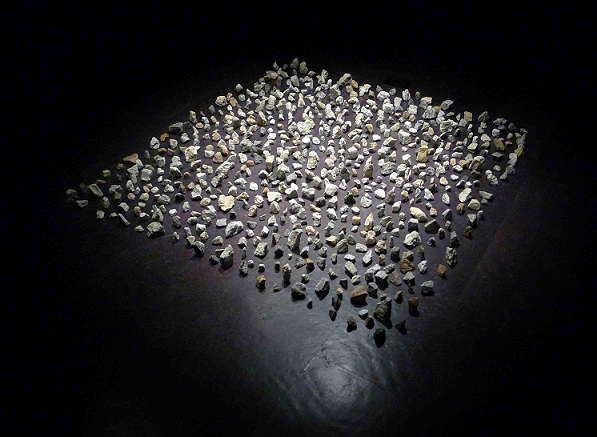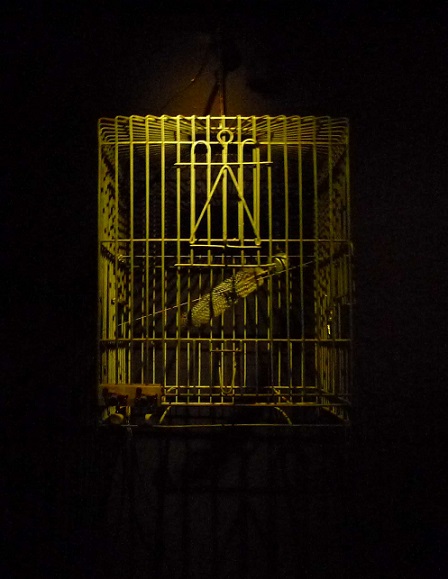Reviews & Articles
Sound Art in Hong Kong
John BATTEN
at 11:31am on 20th October 2015





Captions:
1. Tomoko Suavage, In Curved Water, mixed media sound installation, The Empty Gallery, 2015.
2. & 3. Sound art performances at Sonic Anchor: Andia Lai on his 'musical' robots and Wang Hsin-jen's complex graphics.
4. Rolf Julius, Large Soundgarden, mixed media and speaker, 2015, The Empty Gallery, 2015.
5. Rubén D’Hers' birdcage, showing details of moving feather, The Empty Gallery, 2015.
All photographs by John Batten
(原文以英文發表,題為〈香港的聲音藝術〉。)
A further maturing of Hong Kong’s art scene can be seen in the crossover of art and music. Hong Kong is surprisingly well served with Western and Chinese classical music programming. Apart from the itinerant Chinese opera and music ensembles that perform during the city’s festivals, the city’s orchestras and music festival initiatives of the Leisure & Cultural Services Department and other organisations offer a varied, year-round programme, consolidated by private initiatives. Particularly successful is Premiere Performances and their February chamber music festival and stimulating programming throughout the year. Meanwhile, the New Music Ensemble promotes modern and contemporary compositions through its own festival and performances.
Earlier this year, the Hong Kong Philharmonic Orchestra faced criticism for conservative programming during their current season. Audiences, however, have shown a greater acceptance of contemporary music and ambitious musical presentations, which is reflected in the more adventurous repertoire of the Hong Kong Sinfonietta. If the Philharmonic does not meet changing audience expectations, their claims for residency at the new concert hall of the West Kowloon Cultural District could be challenged!
Until recently, Hong Kong music and art led separate paths. This has considerably narrowed with such initiatives as soundpocket, a sound organization committed to the recording of everyday sounds and significant Hong Kong moments and whose Around Sound Art Festival, to be held next in mid-November, brings performances, talks and exhibitions focused on sound art’s “multi-layered range of perspectives.” Contemporary Musiking and the Hong Kong Arts Centre, with funding from the Hong Kong Arts Development Council, have presented a fascinating and oft-exciting series of sound art and experimental music over the last few years with their Sonic Anchor performances, held approximately every month.
The two previous Sonic Anchor performances were each different. In July, Betty Apple (Cheng Yi-ping) from Taiwan and Ingrid Lee, Hong Kong/USA educated but currently a Netherlands-based composer and performer, focused on “vinyl-manipulation and creative sampling.” In October, Andia Lai from Hong Kong and Wang Hsin-jen of Taiwan presented “Interfacing Dynamics,” two highly visual sound performances.
One of Ingrid Lee’s performance pieces utilized her own recording, Only Edison Could Speak to the Dead, which was packaged in a custom-made sandpaper record cover. Each time the record was taken out, it was deliberately scratched. Ingrid calmly moved backwards-and-forwards placing this recording on two separate record players – a slow visual ritual creating an industrial sound background. It was a tense visual and aural experience for the audience: an artist surrounded by scratchy primordial noise as the record played out into cool silence.
Betty Apple from Taiwan took an even more physical approach. Challenging nationalism and aspirations of border incursions by neighbouring countries, she played a long-playing record of different national anthems from around the world while throwing objects at the revolving record and turntable. With added sounds, it was a clashing noisy mixture as she performed with frenzied, physical violence.
Wang Hsin-jen used algorithms to manipulate one of his electronic compositions, which further adjusted a projected back-screen video of mathematically calculated graphic images. The audience sat on the floor to better ‘feel’ the performance. This high-tech electronic approach contrasted with Andia Lai’s robot toys that were wired-up to create sounds of noisy electronic feedback and resistance.
The Empty Gallery is a new privately funded, semi-commercial, art space in Tin Wan, near Aberdeen, whose minimal interior design is completely black, including the foyer on exiting the elevator. This entrance can be disorientating, but once eyes are accustomed to the dark interior, the art displays come into clearer focus. Its recent Sonorous Objects exhibition was entirely devoted to sound art and featured four overseas artists who have excelled in the field.
Taking a central position in the gallery’s main space is Tomoko Sauvage’s In Curved Water, a beautiful installation of slowly melting hanging ice-block shards (which are replaced every day). The sound of dripping water into porcelain bowls is amplified and from different positions in the room the audience has a beautiful crystalline view to watch and listen to her version of passing time. A similar aesthetic is seen in Rolf Julius’ Large Stonegarden: small jagged stones collected from a beach in Finland are assembled in a rectangular formation, a speaker placed amongst the stones emits a recording of the low chirping of birds at dawn. The juxtaposition of still stones alongside animated nature gives a cinematic quality to this quiet sound installation.
A small, enclosed room in the gallery allowed a total environment for the showing of three Marc Hurtado videos originally filmed in the varied colours of Super 8 and 8 millimetre film. Seen are abstracted images of the artist and nature, often double—exposed, with whisperings of poetry. It offers a glimpse of 1990s bohemian psychedelia.
Rubén D’Hers starts and closes the exhibition with a sound installation housed in two birdcages. A single feather attached to a small motor randomly strums on two wire strings giving a guitar or zheng-like resonance, activated by the distant sounds of recorded bird-song. It is a delicate finale – possible, as only the music of sound can achieve.

Rubén D’Hers' birdcage, showing details of moving feather, The Empty Gallery, 2015.
Link for further information:
Marc Hurtado's film Royaume
This article was originally published in The Peak magazine, November 2015.
原文刊於The Peak,2015年11月。
